#Liver disease diagnosis
Explore tagged Tumblr posts
Text
Liver Function Test: A Detailed Guide for Accurate Reports and Health Awareness
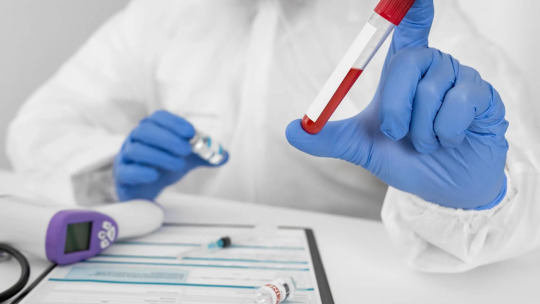
Unlock insights into liver health with our comprehensive guide on liver function tests. Learn about their importance, common tests, result interpretation, and debunked myths. Discover why Dr. Vaidya’s Laboratory in Borivali offers the best, hassle-free liver function tests with free home blood sample collection services. Prioritize your well-being today!
#Liver Function Tests#Liver Health#Dr. Vaidya's Laboratory#Borivali#Liver disease diagnosis#Liver enzyme tests#Blood tests for liver health#Home blood sample collection#NABL accredited lab services#medical diagnostics
0 notes
Text
Honestly sooooooo fucked up that I thought my overwhelming daily fatigue and debilitating body pain was a product of the awful working conditions I was under for years and years... and yet, despite being out of work for half a year now, I'm still so fatigued and in pain all the time??? Like come on man that's not fair
Oh well maybe I have liver disease and they'll treat it and then I am magically so much more energized like I was as a kid. We can only hope !!!!
#speculation nation#negative/#um. not hoping i have liver disease but the blood tests blatantly state that it's not working entirely right.#not like major enough to be an immediate health emergency. or else my doctor probably wouldve called me#rather than referring me to radiology.#im just hoping that it's something easy to treat. it really would be so nice for my problems to be fixed like that.#and im mentioning it in conjunction with the fatigue just bc it can cause fatigue. ya kno.#probably is a good thing i caught it this early whatever it is.#like maybe it's Not fibromyalgia. but the fact that i pursued diagnosis for fibromyalgia spurred the blood tests#which alerted my doctor to the abnormal liver enyzmes.#if i hadnt pursued diagnosis who knows how much longer this wouldve gone on like this...#so! im still not happy to be doing a Fucking ultrasound for my liver. but. if it means catching whatever this is early#then like. it'll be worth it. doubly so if it does end up fixing my fatigue problems.#or even just some of them. i dont even need to be at 100% of what others can do#i just wanna be able to do half an hour of chores without feeling like im going to collapse 😭😭😭😭#it's really very troublesome. my life would be so much easier if i had the energy to do more than one thing per day.#(and if i do more than one thing i end up nearly bedridden the rest of the day. like today lol.)#im just trying to look on the bright sides so i dont start freaking out again about my liver not working right.#ultimately. even if i dont feel amazing. i dont feel all that different from how ive lived the past decade of my life.#or at least the most recent years. i kind of feel like my chronic pain has gotten worse. maybe fatigue too.#though i do know ive been dealing with both for however long. idk. might be recency bias. who knows.#ANYWAYS. im not actively dying. so i'll live to my appointments. and then i will hope it's smooth sailing from there.#(oh god i hope i wont need surgery. i dont want surgery. please im trying to graduate college i do not want surgery)#(god why is my luck always so bad)
4 notes
·
View notes
Text
Meta Description: Learn about the common signs, diagnosis methods, available treatments, and the impact of fatty liver disease on life expectancy in this comprehensive guide.
#gastroenterologist#endoscopy#celiac disease#hepatitis#digestive health#Fatty liver disease#Hepatic steatosis#Signs of fatty liver disease#Fatty liver disease diagnosis#Fatty liver disease treatments#Liver health#Liver function tests#Liver biopsy#Liver inflammation#Liver imaging#Liver complications#Liver transplantation#Liver fibrosis#Liver cirrhosis
0 notes
Text
Liver Disease: How To Identify Liver Problems?
Are you aware of the vital role your liver plays in keeping your body in harmony? What is liver disease, and how can you identify potential problems early on? In this comprehensive guide, we'll delve into the world of liver health, exploring the stages, symptoms, diagnosis, and treatment of liver disease. Discover proactive measures to prevent liver issues and learn when it's crucial to consult a doctor, all within the comfort of your online space.
#what is Liver disease#how to identify liver problems#stages of liver disease#symptoms of liver disease#diagnosis of liver disease#liver disease treatment#how to prevent liver disease#when to consult a doctor#blood test#online doctor consultation
0 notes
Text
When an anime girl is dying and the doctor just says “her body is failing”
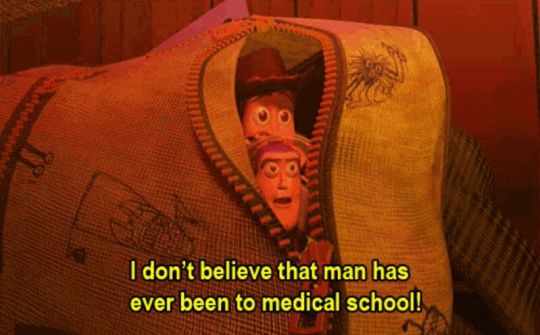
#I don’t believe that writer has ever set foot in a hospital#WHAT. IS. THE DIAGNOSIS.#is it heart failure is it liver failure is she having a stroke???#no her body is failing. it’s just failing.#bitch I will make your body fail if you don’t give me an actual concrete diagnosis#the diagnosis is. body fail disease.#AAAAAAAAAAAAAAAAAAAAAA#the treatment is lay in a fancy bed and wear a loose side ponytail
0 notes
Text
Fatty Liver Disease: Important Causes, Symptoms, and Treatment
Fatty Liver Disease: Important Causes, Symptoms, and TreatmentIntroductionWhat is Fatty Liver Disease?Causes of Fatty Liver Disease Poor Dietary Habits Sedentary Lifestyle Obesity Alcohol ConsumptionSymptoms of Fatty Liver Disease Fatigue Abdominal Discomfort Jaundice SwellingDiagnosing Fatty Liver Disease Blood Tests Imaging Studies Liver BiopsyTreatment and Management Lifestyle Changes Balanced…
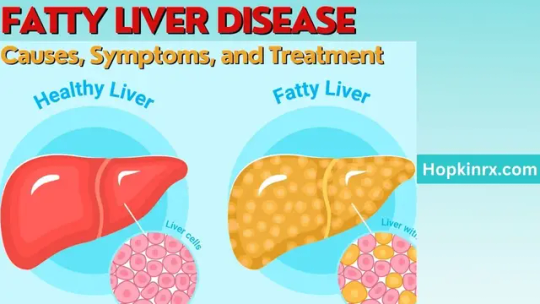
View On WordPress
#Alcoholic fatty liver#Fatty liver causes#Fatty liver complications#Fatty liver diagnosis#Fatty liver management#Fatty liver prevention#Fatty liver risks#Fatty liver symptoms#Fatty liver treatment#Hepatic steatosis#Liver and alcohol#Liver biopsy#Liver care#Liver cirrhosis#Liver damage#Liver disease progression#Liver exercise benefits#Liver function#Liver Health#Liver health tips#Liver inflammation#Liver steatosis#Liver-friendly diet#Non-alcoholic fatty liver#Obesity and fatty liver
0 notes
Text
Writing Notes: Coma
Coma - (from the Greek word ‘‘koma,’’ meaning deep sleep)
A state of extreme unresponsiveness, in which an individual exhibits no voluntary movement or behavior.
In a deep coma, even painful stimuli (actions which, when performed on a healthy individual, result in reactions) are unable to affect any response, and normal reflexes may be lost.
Coma is the result of something that interferes with the functioning of the cerebral cortex and/or the functioning of the structures that make up the RAS. In fact, a huge and varied number of conditions can result in coma. A good way of categorizing these conditions is to consider the anatomic and the metabolic causes of coma:
Anatomic causes of coma are those conditions that disrupt the normal physical architecture of the brain structures responsible for consciousness, either at the level of the cerebal cortex or the brainstem.
Metabolic causes of coma consist of those conditions that change the chemical environment of the brain, thereby adversely affecting function.
As in any neurologic condition, history and examination form the cornerstone of diagnosis when the patient is in a coma; however, history must be obtained from family, friends, or EMS.
The Glasgow Coma Scale is a system of examining a comatose patient.
It is helpful for evaluating the depth of the coma, tracking the patient’s progress, and predicting (somewhat) the ultimate outcome of the coma.
It assigns a different number of points for exam results in three different categories:
opening the eyes,
verbal response (using words or voice to respond), and
motor response (moving a part of the body).
Fifteen is the largest possible number of total points, indicating the highest level of functioning.
The highest level of functioning would be demonstrated by an individual who spontaneously opens his/her eyes, gives appropriate answers to questions about his/her situation, and can carry out a command (such as ‘‘move your leg’’ or ‘‘nod your head’’).
Three is the least possible number of total points and would be given to a patient for whom not even a painful stimulus is sufficient to provoke a response.
In the middle are those patients who may be able to respond, but who require an intense or painful stimulus, and whose response may demonstrate some degree of brain malfunctioning (such as a person whose only response to pain in a limb is to bend that limb in toward the body).
When performed as part of the admission examination, a Glasgow score of three to five points often suggests that the patient has likely suffered fatal brain damage, while eight or more points indicates that the patient’s chances for recovery are good.
Expansion of the pupils and respiratory pattern are also important.
Metabolic causes of coma are diagnosed from blood work and urinalysis to evaluate blood chemistry, drug screen, and blood cell abnormalities that may indicate infection.
Anatomic causes of coma are diagnosed from CT (computed tomography) or MRI (magnetic resonance imaging) scans.
Coma is a medical emergency, and attention must first be directed to maintaining the patient’s respiration and circulation, using intubation and ventilation, administration of intravenous fluids or blood as needed, and other supportive care.
If head trama has not been excluded, the neck should be stabilized in the event of fracture.
It is obviously extremely important for a physician to determine quickly the cause of a coma, so that potentially reversible conditions are treated immediately. For example, an infection may be treated with antibiotics; a brain tumor may be removed; and brain swelling from an injury can be reduced with certain medications.
Various metabolic disorders can be addressed by supplying the individual with the correct amount of oxygen, glucose, or sodium; by treating the underlying disease in liver disease, asthma, or diabetes; and by halting seizures with medication.
Because of their low incidence of side effects and potential for prompt reversal of coma in certain conditions, glucose, the Bvitamin thiamine, and Narcan (to counteract any narcotic-type drugs) are routinely given.
Source ⚜ More: Notes & References ⚜ Writing Realistic Injuries
#writing reference#writeblr#dark academia#spilled ink#writers on tumblr#literature#writing inspiration#writing notes#writing prompt#poets on tumblr#writing ideas#creative writing#fiction#medicine#coma#writing resources
92 notes
·
View notes
Text
🧵Meet 15 Jewish Nobel Prize Winners Who Changed History🧵
The Jewish population constitutes just 0.18% of the world (15.3 million out of 8.2 billion), yet approximately 20-30% of Nobel Prize winners in fields like Physics, Chemistry, and Medicine are Jewish. This incredible fact highlights the Jewish community's historic contributions to humanity.
Let’s meet just 15 of the over 200 Jewish Nobel Prize winners.
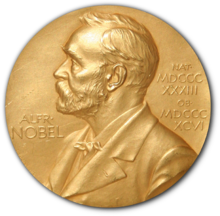
1/ Albert Einstein (1921, Physics).
Einstein was born in Germany to a secular Jewish family. His groundbreaking discovery of the photoelectric effect laid the foundation for quantum mechanics, earning him the Nobel Prize.
▪ His theory of relativity (E=mc²) reshaped our understanding of gravity and spacetime.
▪In 1933, Einstein fled Nazi Germany to the U.S., where he became a vocal advocate for civil rights and Zionism. ▪He helped inspire the Manhattan Project but later became an advocate for nuclear disarmament.

2/ Niels Bohr (1922, Physics).
Born in Denmark to a Jewish mother, Bohr revolutionized atomic physics.
▪His Bohr Model showed electrons orbit the nucleus in distinct energy levels. ▪During WWII, Bohr worked on the Manhattan Project after escaping Nazi persecution. ▪Beyond science, Bohr advocated for global cooperation and peaceful nuclear energy use.

3/ Shmuel Yosef Agnon (1966, Literature).
Born in Galicia (modern-day Ukraine), Agnon immigrated to Ottoman Palestine in 1908.
▪His novels and stories delve into Jewish tradition, spirituality, and the tension between modernity and faith. ▪His acclaimed works include A Simple Story and Only Yesterday. ▪Agnon’s Nobel solidified Hebrew literature's global recognition.

4/ Rosalyn Yalow (1977, Medicine).
Yalow, born in New York to a Jewish family, co-developed radioimmunoassay (RIA), a groundbreaking technique to measure hormones in blood.
▪Her work revolutionized the diagnosis and treatment of diseases like diabetes. ▪Despite gender biases in science at that time, she became the second woman to win the Medicine Nobel.

5/ Baruch Blumberg (1976, Medicine).
Blumberg, a Jewish-American physician, discovered the Hepatitis B virus and developed its vaccine.
▪His research saved millions from liver disease and cancer.
▪Blumberg also served as the first director of NASA’s Astrobiology Institute, exploring life’s origins in the universe.
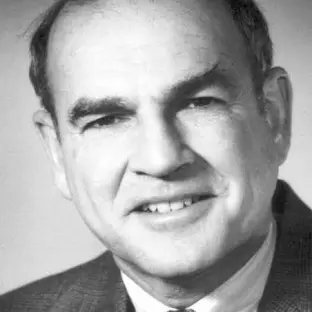
6/ Lev Landau (1962, Physics)
Born in Baku, Azerbaijan, to a Jewish family, Landau made ground-breaking contributions to condensed matter physics and quantum mechanics.
▪His groundbreaking work on superfluidity explained the behavior of liquid helium at extremely low temperatures. ▪Landau also developed the "Landau-Lifshitz equations," foundational in describing ferromagnetism. ▪Known as a genius in theoretical physics, his "Landau Levels" remain crucial in quantum mechanics.

7/ Richard Feynman (1965, Physics).
Feynman, born to Jewish parents in New York, shared the Nobel for his work in quantum electrodynamics (QED).
▪Known for his brilliance and humor, he revolutionized particle physics with "Feynman diagrams." ▪He contributed to the Manhattan Project and inspired countless scientists through his lectures and books like Surely You’re Joking, Mr. Feynman!

8/ Elie Wiesel (1986, Literature).
A Romanian-born Holocaust survivor, Wiesel wrote Night, a searing memoir of his Auschwitz experience.
▪He dedicated his life to Holocaust education and combating hatred. ▪Wiesel’s Nobel recognized his literary contributions, ensuring the horrors of the Holocaust were never forgotten.
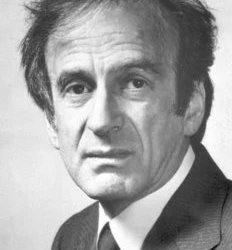
9/ Herbert Hauptman (1985, Chemistry).
Hauptman, a Jewish-American mathematician, co-developed direct methods for solving crystal structures, revolutionizing crystallography.
▪His work paved the way for advances in drug design, enabling scientists to develop life-saving medications. ▪Hauptman’s methods remain foundational in understanding molecular structures in biology and medicine.

10/ Robert Aumann - Yisrael Aumann. (2005, Economics).
An Israeli-American mathematician, Aumann revolutionized game theory, analyzing strategic interactions between rational decision-makers.
▪His work, particularly on "repeated games," has applications in economics, military strategy, and even evolutionary biology. ▪Aumann is an observant Orthodox Jew and has been a vocal advocate for Israel's security and has connected his mathematical insights with the Talmudic concept of fairness and justice. He often reflects on his Jewish heritage in his work and public speeches.

11/ Aaron Ciechanover (2004, Chemistry).
Ciechanover, born in Haifa, Israel, discovered the ubiquitin-mediated protein degradation system.
▪This mechanism explains how cells identify and destroy faulty or damaged proteins, which is essential for maintaining health. ▪His findings have significant implications for treating diseases like cancer, Alzheimer's, and Parkinson's.

12/ Avram Hershko (2004, Chemistry).
Hershko, born in Hungary and a Holocaust survivor, worked alongside Ciechanover on the ubiquitin system.
▪His research showed how proteins are tagged for destruction, which is vital for cellular health. ▪Hershko’s journey from surviving the Holocaust to becoming a Nobel laureate highlights the resilience and brilliance of Jewish scientists.

13/ Daniel Kahneman (2002, Economics).
Kahneman, born in Tel Aviv, is a psychologist whose work transformed economics.
▪He co-authored Thinking, Fast and Slow, exploring how cognitive biases affect decision-making. ▪His prospect theory explained how people assess risk, challenging classical economic theories of rationality.

14/ Ada Yonath (2009, Chemistry).
An Israeli crystallographer, Yonath is celebrated for uncovering the 3D structure of ribosomes, the cell's protein factories.
▪Her work advanced the development of antibiotics targeting bacterial ribosomes, combating antibiotic resistance. ▪Yonath is the first Israeli woman to win the Nobel Prize in Chemistry.

15/ Saul Perlmutter (2011, Physics).
An astrophysicist from Berkeley, Perlmutter co-discovered that the universe’s expansion is accelerating due to "dark energy."
▪His work confirmed the existence of this mysterious force, which makes up about 68% of the universe. ▪Perlmutter’s groundbreaking discovery led to a wave of new theories and observations in cosmology, changing how we understand the cosmos and our place within it.

Conclusion.
Of the 976 individual winners of the Nobel Prize and the Nobel Memorial Prize in Economic Sciences from 1901 through 2024, at least 217 have been Jews or people with at least one Jewish parent, an astonishing 22% of all recipients.
This amazing achievement underlines the huge contribution that the Jewish community has made to world progress in a wide range of areas, from science and medicine to literature and economics.
With only 0.2% of the world's population, Jewish people have continued to shape and inspire the world with intellectual perseverance and innovation, thus leaving a lasting legacy for future generations.
Correction *Jewish population is at 15.8 million.
Correction: Wiesel won for peace.
@AP_from_NY
55 notes
·
View notes
Text
Months: Travis Wheatley x Reader

Tagging: @kmc1989 @trublu2u @yousigned-upforthis @queenslandlover-93
Companion piece to:
The Circuit - You're the first person Travis tells about his condition.
Beachside - Travis's diagnosis gives him a fresh perspective.
Lifetime - You promise to spend a lifetime with Travis, no matter how short it may be.

It’s Sunday afternoon and Travis is asleep on the couch with his head resting on your lap, your fingers combing lightly through his hair. He’s been napping for a couple of hours now, his arms crossed over his chest as you listen to the even sounds of his breathing. It’s been happening a lot recently, ever since the doctor hold him he was in acute liver failure.
It’s not a matter of years anymore, he’d told the two of you. It’s months.
The car ride home had been quiet because Travis, he doesn’t want to face this just yet and you don’t blame him because the truth is, you’re not ready to face it either. You’re not ready to let him go.
“I want to have a part of you.” You say quietly as you’re making dinner that night. He’s cooking steaks on the stove while you chop peppers for the salad. “When you go, I want to keep a part of you with me.”
He turns the stove off then because the who of you talked about having kids once upon a time. The plan had always been after you were married, when the two of you settled down in your own little ranch in Montana.
“Honey…” He begins, his hands coming to rest upon your waist as you set the knife down. “I don’t think that’s a decision we should be making right now.”
“When should we be making it?” You snap as you turn to face him. “In a couple of months when you’re too sick to move, when you’re gone?”
The words hit him like a slap because you aren’t wrong, his time, it is running out and he understands why you would want a piece of his memory after he leaves this world but he also understands it’s an emotional response to the reality you’re facing.
If he does succeed in getting you pregnant and that’s a big if, considering your age and his circumstances, the likelihood is he won’t live to see his baby being born, he won’t get to hold them in his arms, to sing the lullabies is momma used to sing. The thought of that, it tears him up inside because there is nothing in this world he wants more than to marry you, to give you his baby but he knows all of that is a symptom of his condition.
“Gina honey.” He whispers. “I can’t give you that, not like this.”
You break then, he watches the pieces of you crumble as you push away from the counter, slipping away from him. You’re out the back door before he can stop you, slamming it shut so hard that the glass vibrates in the panel. Travis puts his hands on the counter, trying to catch his breath because this hurts, it hurts so fucking much to listen to you breaking down on the porch outside, sobbing your fucking heart out.
His eyes start to sting because this thing, this fucking disease it won’t happy until it’s destroyed every part of him.
Love Travis? Don’t miss any of his stories by joining the taglist here.
Interested in supporting me? Join my Patreon for Bonus Content!
Like My Work? - Why Not Buy Me A Coffee

107 notes
·
View notes
Text
Also preserved in our archive (Check out all of our long covid resources!)
BY Rhys Richmond
Research reports and detailed case studies from doctors and other providers can tell us a lot about Long COVID. But to understand the full scope of the disease and its impact, we must also listen to the experiences of patients who are suffering.
Today’s post features a contribution from one of our readers, who details his experience with Long COVID and a preexisting illness—in his case, myalgic encephalomyelitis/chronic fatigue syndrome (ME/CFS). As someone who suffers from both ME/CFS and Long COVID, Billy Hanlon—in his role as the director of advocacy and outreach at the Minnesota ME/CFS Alliance—also advocates for advancing research into these conditions.
While researchers and clinicians have noted parallels between ME/CFS and Long COVID, as well as among other post-acute infection syndromes, much more research is needed to fill the knowledge gaps. Some researchers hypothesize that multi-organ damage wreaked by COVID-19 might explain how people with preexisting disease in certain organs (such as the heart, lung, liver, and kidney) might be at higher risk of severe COVID-19 affecting those same organs. Furthermore, research has linked an increased risk of developing post-acute sequelae of COVID-19 (Long COVID) to having a preexisting medical condition prior to SARS-CoV-2 infection
In a sense, we’re beginning to see that COVID-19 infections might take advantage of less-than-perfect health to cause persistent symptoms. While other viruses have exhibited similar opportunistic patterns—for example, influenza has been shown to cause more severe illness and hospitalizations in patients with obesity and heart disease—the long-lasting and poorly understood manifestations of Long COVID merit particular attention. In Hanlon’s account below of his own struggles with ME/CFS and Long COVID, he also details how you may be able to help advocate for more research into both of these conditions.
A patient’s chronicle of life with ME/CFS and Long COVID I’m a resident of Minneapolis, living with ME/CFS and Long COVID.
In 2017, at age 28, I suffered from an acute viral-like illness. Before long, I began experiencing severe neurological complications, such as difficulty with concentration and comprehension, as well as heart palpitations. The newfound, crushing exhaustion was unlike anything I had ever experienced. Physical or mental exertion seemed to exacerbate these complications, a phenomenon called post-exertional malaise (PEM), the cardinal symptom of ME/CFS and now Long COVID. In 2022, following a second COVID-19 infection, my symptoms worsened, leading to a Long COVID diagnosis.
As my personal experience can attest, ME/CFS and Long COVID are multi-systemic diseases involving pathologies of the brain, immune system, autonomic nervous system, and energy metabolism system. Many patients report that the onset of the illness (ME/CFS) is preceded by a viral infection, such as Epstein-Barr virus, H1N1 flu, or SARS-CoV-2.
Despite my best efforts, I have never recovered from ME/CFS and Long COVID. There’s no cure or FDA-approved treatment for these conditions, which affect people of every age and background. Very few American medical schools include ME/CFS and Long COVID care in their curricula, so only a handful of specialists in the country are trained to treat these diseases. As a result, many patients are disbelieved or discredited in medical settings, leaving essentially no system of care to lean on. I learned firsthand about the barriers and inequities faced by patients with ME/CFS and infection-associated chronic illnesses. Care for these conditions is vastly under-resourced, under-funded, under-studied, largely overlooked, and highly marginalized.
I anticipated these formative years of my adulthood to be marked by time spent with friends and family (my wife and nephews), new homes, job promotions, and vacations, but instead I find myself in a twilight world of this medical enigma. My life trajectory was headed one way, then viral illness has completely redirected it. I now spend the majority of my time horizontal, forging ahead as best as my body will permit, advocating with the will that still endures. ME/CFS and Long COVID rob futures and confine lives. Coming to terms with losing my career, my independence, and so many hopes and dreams has been as difficult as the chronic illness.
A lot more could be said about the profound loss I’ve felt professionally, physically, personally, and socially, but I instead want to focus on actionable items that anyone reading this can do to help support future care for this rapidly growing group of people affected by these illnesses.
First, Sen. Bernie Sanders (I-Vt.) recently announced a legislative proposal for The Long COVID Moonshot Act. This proposal is aptly titled as the advancements needed surely warrant a moonshot—the term used when Congress marshals resources across the federal government to expedite progress. These infection-associated chronic illnesses have historically been left at the end of the queue for research funding.
You can reach out to your elected official and ask for their support on this proposal, which will help accelerate and prioritize research, diagnostics, and treatments. This proposal would provide $1 billion in mandatory funding per year for 10 years so that the National Institutes of Health (NIH) can respond to this crisis with the sense of urgency that it demands. Recently, Reps. Ilhan Omar (MN-05) and Ayanna Pressley (MA-07) have also introduced a companion bill for the Long COVID Moonshot in the House of Representatives.
Second, an ME/CFS Research Roadmap Report was approved in May by the National Institute of Neurological Disorders and Stroke (NINDS). This is a step in the right direction toward clinical trials, but now we need the NIH to robustly fund it. You can contact your elected officials and ask that the NIH help make this a reality. These are also efforts that could pay dividends toward an ME/CFS platform clinical trial. This was recently recommended by Senior Investigator and Clinical Director Dr. Avindra Nath following the completion of the NIH ME/CFS Intramural Study. A platform trial or advancements in the Research Roadmap Report could potentially yield a lot of intel for Long COVID treatments and help inform the RECOVER Initiative, a research program by the NIH that aims to understand, diagnose, prevent, and treat Long COVID..
Lastly, Long COVID and ME/CFS were highlighted in May at the Senate Labor, Health and Human Services, Education and Related Agencies Subcommittee FY25 NIH Hearing. During the hearing, NIH Director Dr. Monica Bertagnolli stated, “… I want to say about Long COVID and ME/CFS—we are so grateful for our partnership with the people that are affected by this. They have taught us over the last two years what we needed to do. Now we just need to deliver for them.” Millions of people would agree. A crucial step would be to establish a dedicated Center at the NIH focused on Long COVID, ME/CFS, and infection-associated chronic conditions and illnesses.
Rhys Richmond is an MD candidate at Yale School of Medicine
#mask up#covid#pandemic#public health#wear a mask#covid 19#wear a respirator#still coviding#coronavirus#sars cov 2#long covid
58 notes
·
View notes
Text

‘Curse’ Behind King Tutankhamun’s Tomb Mysterious Deaths Finally Solved
The unsettling curse of King Tutankhamun’s tomb in Egypt has bewildered archaeologists since it’s been feared to be linked to the mysterious deaths of multiple excavators who discovered it in 1922.
However, a scientist now claims to have solved the mysteries of the infamous “Pharaoh’s Curse” more than 100 years later.
Toxic levels of radiation emanating from uranium and poisonous waste are believed to have lingered inside the tomb since it was sealed over 3,000 years ago, Ross Fellowes wrote last month in the Journal of Scientific Exploration (JSE).

The burial chamber in the tomb of Tutankhamun, near Luxor, Egypt.
The radiation level inside Tutankhamun’s tomb is so high that anyone who comes in contact with it could very likely develop a fatal dose of radiation sickness and cancer.
“Both contemporary and ancient Egypt populations are characterized by unusually high incidences of hematopoietic cancers, of bone/blood/lymph, for which a primary known cause is radiation exposure,” Fellowes wrote in his study.
However, this radioactivity isn’t isolated to Tutankhamun’s tomb.
Fellowes revealed that “unusually high radiation levels have been documented in Old Kingdom tomb ruins” and spread throughout sites in Egypt.
“Radiation has been detected by the Geiger counter at two sites at Giza adjacent to the pyramids,” he wrote, adding that radon — a radioactive gas — has also been detected in “several underground tombs at Saqqara.”
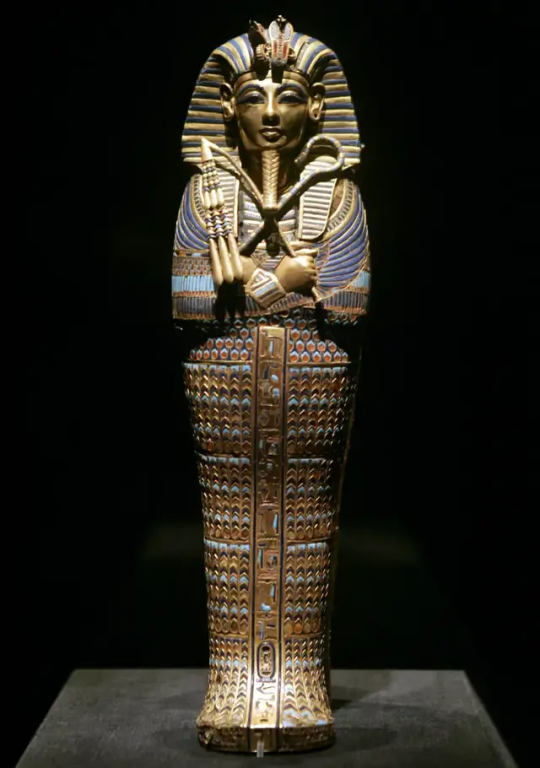
The “Coffinette for the Viscera of Tutankhamun,” which contained the king’s mummified liver, depicts him as Osiris, holding a crook and flail.
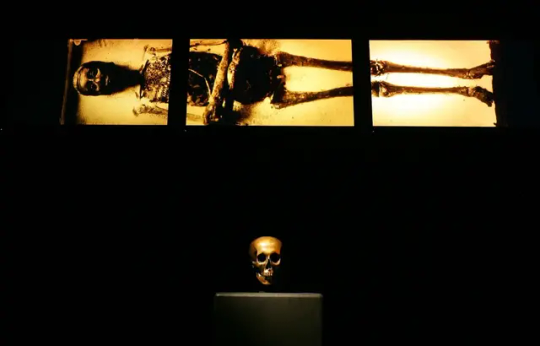
Medical imagery of Tutankhamun is shown above a replica of King Tut’s skull on display during the “Tutankhamun And The Golden Age Of The Pharaohs” at the Los Angeles County Museum of Art in California.
These readings were all found to be “intensely radioactive.”
“Modern studies confirm very high levels of radiation in ancient Egyptian tombs, in the order of 10x accepted safety standards,” the study shared.
It’s also theorized that those who built the ancient tombs were aware of the toxins based on the eerie warnings carved on the walls.
“The nature of the curse was explicitly inscribed on some tombs, with one translated presciently as, ‘they that break this tomb shall meet death by a disease that no doctor can diagnose,’” Fellowes wrote.

Outside the tomb of Tutankhamun during the 1922 excavation in the Valley of the Kings in Egypt.
Other ominous translations like “forbidden” because of “evil spirits” may have significantly fueled the fear that supernatural curses lingered in the ancient sites.
Those fears intensified with the mysterious deaths of Lord Carnarvon, who funded the excavation in 1922 and reportedly walked through the treasured filled rooms — and multiple others after they unsealed the tomb.
“Carnarvon was dead within a few weeks of the uncertain diagnosis of blood poisoning and pneumonia,” Fellowes wrote.
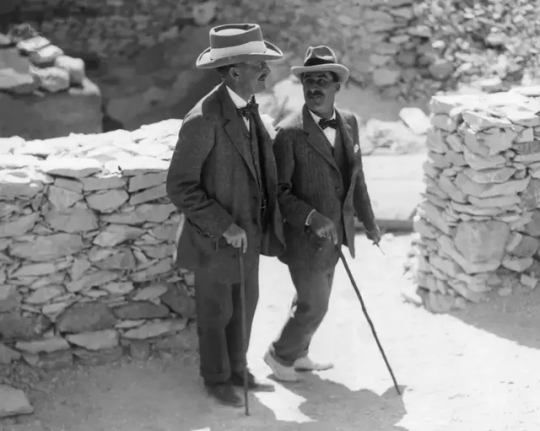
Egyptologist Howard Carter (R) walks with archaeologist Lord Carnarvon, the patron of his research, outside the tomb of King Tutankhamun in 1922.
Egyptologist Arthur Weigall allegedly told colleagues that Carnarvon would “be dead within six weeks” upon entering, the study claimed.
Howard Carter, the first person to walk inside Tutankhamun’s tomb with Carnarvon, died in 1939 after a long battle with Hodgkin’s lymphoma, which was suspected to be caused by radiation poisoning.
British Egyptologist and independent excavator Arthur Weigall was present at the opening of Tut’s Tomb and is also credited with starting the ‘myth’ of the curse.
He died of cancer at 54 years old in 1934.

Workers remove a tray of chariot parts from the Tomb of Tutankhamun in the Valley of the Kings, Egypt, in 1922.
In total, six of the 26 people present when the tomb was opened died within a decade from asphyxia, stroke, diabetes, heart failure, pneumonia, poisoning, malaria and X-ray exposure.
While the deaths can be seen as odd, the curse theory was also likely fueled by the oddities that happened when it opened.
Carnarvon had reportedly suffered a mosquito bite that became severely infected.
Around the time excavators opened the tomb, Cairo reportedly suffered a bizarre power outage and a freak sandstorm, according to National Geographic.’
At one point during the excavation, Carnarvon’s favorite dog allegedly let out a chilling howl and suddenly dropped dead.

A photograph showing guards standing outside the tomb of Tutankhamun in Egypt in 1922.

A sacred cow being removed from Tomb of Tutankhamun in 1922.
From a historical perspective, the discovery of the tomb in the Valley of Kings is considered one of the most fascinating finds that gave modern society a glimpse into the Egyptian royalty voyage into the afterlife.
Five thousand items, including solid gold funeral shoes, statues, games, and strange animals, were discovered inside Tutankhamun’s tombs.
It would take the excavators ten years to clear the tomb of its treasure.

The golden funerary mask of Tutankhamun.
The unsealing and studying of the tomb is also credited with launching the modern era of Egyptology.
Tutankhamun took the throne as pharaoh around nine or ten years old and ruled between 1332 BC and 1323 BC.
However, he died by the time he turned 18.
There are no surviving records of Tutankhamun’s death and how the young pharaoh died remains a mystery.
However, Tutankhamun is suspected to have suffered from several health issues — likely linked to his father, Akhenaten, and his mother, Nefertiti, being brother and sister.
By Richard Pollina.
#‘Curse’ Behind King Tutankhamun’s Tomb Mysterious Deaths Finally Solved#King Tutankhamun#Pharaoh’s Curse#Old Kingdom#Valley of the Kings#Lord Carnarvon#Howard Carter#Egyptology#ancient artifacts#archeology#archeolgst#history#history news#ancient history#ancient culture#ancient civilizations#ancient egypt#egyptian history#egyptian mythology#egyptian pharaoh#egyptian antiquities#egyptian art
76 notes
·
View notes
Note
Helloooo your blog is a liver saver for lore enthusiast like me! You know, although infold hadn't release much info on certain crucial aspect in the game but I was wondering what's your take or theory on how Protocore Syndrome works? Is it just another name for a Heart failure Disease or something more? Would love to read more of your fanon idea on it! And thank you for creating this amazing wiki blog! 💕💕💕
Ayyyy lore enthusiasts gang~ And of course! Thank you for reading! Sorry this took SO long to reply to. Had to do some major studying for this one lol.

I want to start off by saying that medical knowledge is not my area of expertise, so this is purely a layman's best interpretation based on everything I could learn at Google University 🤣 I managed to decipher her electrocardiogram (ECG/EKG) report results. But as for what irl diagnosis those results indicate, I simply lack the expertise required to deduce that answer. Even though I couldn't answer the second part of your question (believe me, I tried so hard 😭), I hope this post is still useful to you! To any medical or med school folk out there, now is your time to shine and save the day (pls 🙏).
How Protocore Syndrome Works?
The basic in-game description of Protocore Syndrome is very rudimentary and doesn't really give us a lot to go off of. But here's what we know:
Protocore Syndrome: From the "Deepspace Messages" section of the in-game Spacepedia resource, we learn that it is a unique disease caused by Protocores. There are different types, and they harm the human body in various ways. Currently, the known types are A, E, and Y
Type Y Protocore Syndrome: From the description given in the World Underneath story "No Morning", we learn that it is a heart syndrome that involves that hides in various organs and systems, with a long latency period, and slow progression. By the time it's detected, it's often too late. There is currently no known cure.
Still digging for concrete information to confirm the protaganist's diagnosis, but the story seems to infer she has Protocore Syndrome. (If you have any screenshots or resources that definitively identify her condition, pls dm me and I'll credit you).
From Zayne's statements during her chapter 1 appointment, we learn that she has Protocore fragments in her heart. He goes on to specify the following symptoms:
Heart arrhythmia
Premature ventricular contractions (PVCs)
Heart murmurs
The game shows us glimpses of her medical paperwork too. We are shown her ECG report and summary. After covering her report, I'll explain some potential discrepancies (emphasis on "potential" since I'm nowhere near an expert lol).
ECG Basics:
We're going to get a little technical here. But I think we'll get the most value from the analysis once we understand what we're looking at. The ECG shown in-game is a standard 12-lead report, producing 12 individual strips.
Leads:
There are the six limb leads: I, II, III, aVR (augmented vector right), aVL (augmented vector left), and aVF (augmented vector foot).
Then, there are the six chest leads: V1, V2, V3, V4, V5, and V6.

Intervals & Waves:
For the report details to make more sense, here's a quick reference to aid in the interpretation of different waves, wave interval, gain settings, and speed settings.
And, based on the gain and speed settings detailed below, each small square on her chart represent 40 milliseconds (ms) and each large squares represents 200 ms.
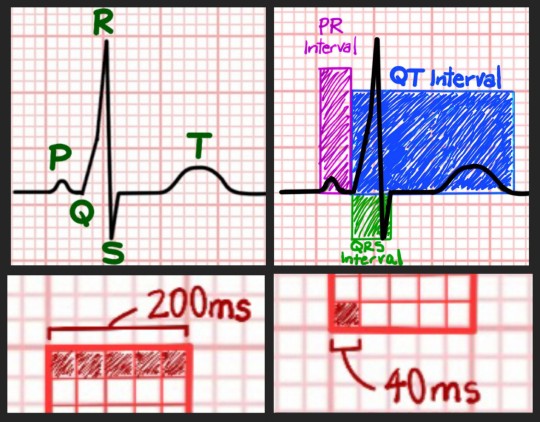
ECG Report Analysis:
Gain, Speed, and Heart Rate:

Gain: 10 mm/mV
Gain is a setting on an ECG machine that controls the size of an ECG trace. The standard gain setting is 10mm/mV, meaning that 10 mm on the screen represents 1 millivolt (mV) of voltage. It appears that Akso Hospital's ECG adheres to this standard.
Speed: 25 mm/s
Speed is the paper speed setting on an ECG machine. So, the Akso Hospital's ECG machine is set to 25 mm/s (meaning that each small square on the chart represents 0.04 seconds).
Heart rate: 85 bpm
Pretty self-explanatoty, but this measures how many times her heart beats within one minute. For women, a normal resting heart rate is considered 60-100 bpm, and hers is within this range.
PR Interval: 138 ms

The PR Interval (or PQ Interval) is the distance between the start of the P wave and the start of the QRS complex. A normal PR Interval is between 120 - 200 ms. Since hers is 138 ms, she falls within the normal range.
QT & QTC Intervals:

QT Interval: 347 ms
The QT Interval is the time between the start of the QRS segment and the end of the T wave. It measures the electrical activity of the heart's ventricles. For a heart rate of 85 bpm, a normal QT Interval would generally be 380 ms or less. So, hers is normal.
QTC Interval: 411 ms
The QTC Interval is the corrected QT interval (thats what the "c" is for). It represents the time it takes the heart's ventricles to contract and relax. It is calculated by adjusting the QT interval for heart rate. A normal QTC interval for women is usually less than 460 ms. Since hers is 411 ms, she's within the normal range.
P, T, and QRS Wave Axes:
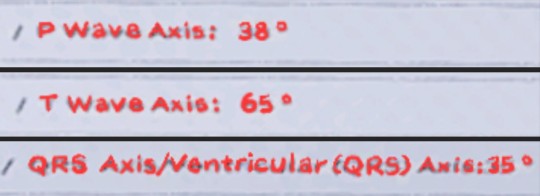
P Wave Axis: 38°
The P wave axis tells us the net direction of the P wave. A normal P wave axis is usually between 0° and 75°. Since hers is 38°, it falls within the normal range.
T Wave Axis: 65°
The T wave tells us the net direction of the T wave. A normal P wave axis is usually between 15° and 75°. Since hers is 65°, it is within the normal range.
QRS Axis: 35°
The QRS Axis tells us the average direction of electrical activity in the heart during ventricular depolarization. A normal adult QRS axis is between -30° and 90°. Since hers is 35°, she falls within the normal range.
SV1 and RV5:

SV1: 0.94 mV
SV1 represents the voltage of the S wave from the V1 lead. It is used to detect ventricular hypertrophy. A normal SV1 is considered to be less than 2.5 mV and hers is within this range.
RV5: 0.85 mV
The RV5 represents the voltage of the R wave from the V5 lead. It is used to measure electrical activity in the left ventricle. An RV5 reading is considered normal if it is less than 3.5 mV and hers is within this range.
QRS Interval: 71 ms

The QRS Interval the interval between the start of the Q wave and the end of the S wave. Represents the time it takes for electrical impulses to spread through the ventricles. A normal QRS Interval is 70-100 ms. Since hers is 71 ms, she's within the normal range.
Potential Discrepancies:
Okay. So, I thought it was a bit strange that all of her ECG readings were within the normal ranges. But I genuinely don't know if a patient can be diagnosed with an irl heart condition despite having an ECG that appears normal. Maybe its a diagnosis determined by other criteria we aren't shown?
Additionally, I looked up ECG strip examples of both cardiac arrhythmias and premature ventricular contractions (PVCs). And comparing them with her charts, I don't see indications of those symptoms in there.
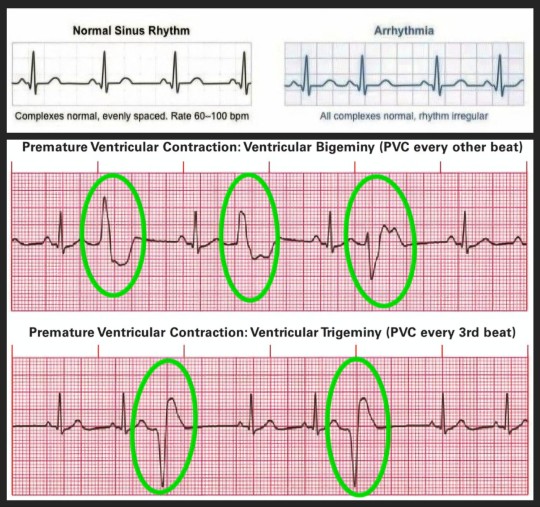
#love and deepspace#lads#tysm <3#thanks for the ask!#ilysmmmm#lads protocore syndrome#love and deepspace protocore syndrome#lads random facts#love and deepspace random facts#random facts mc#love and deepspace mc#lads mc#random facts the protaganist#random facts protaganist#love and deepspace the protaganist#lads the protaganist#lads ecg#love and deepspace ecg#lads ekg#love and deepspace ekg#lads akso hospital#love and deepspace akso hospital#akso hospital
24 notes
·
View notes
Text
#liver diseases#Liver disorders#Hepatic conditions#Liver health#Liver problems#Hepatitis#Cirrhosis#Fatty liver#Liver cancer#Liver function#Liver symptoms#Liver diagnosis#Liver treatment#Liver disease management#Liver disease prevention#Liver disease awareness
0 notes
Photo
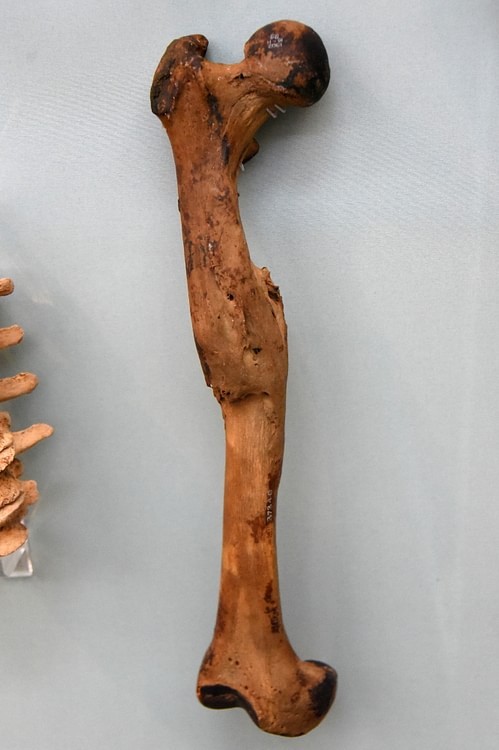
Ancient Egyptian Medicine: Study & Practice
In Europe, in the 19th century CE, an interesting device began appearing in graveyards and cemeteries: the mortsafe. This was an iron cage erected over a grave to keep the body of the deceased safe from 'resurrectionists' - better known as body-snatchers. These men would dig up freshly interred corpses and deliver them, for cash, to doctors wishing to study anatomy. Dissection of a human being was illegal at the time, and until the Anatomy Act of 1832 CE, the only corpses a doctor could work with were those who had been executed for capital crimes.
These did not provide physicians with the number of corpses, nor the assortment of causes of death, they required to better understand anatomy, physiology, and pathology. Doctors recognized that the best way to treat a patient was to understand how the organs of the body worked together and what could affect them, but they were denied access. These physicians paid the resurrectionists large sums of money over the years for dead bodies and would most likely have been surprised or even amused to learn that, in ancient Egypt, the practice of dissection was routine but that no one in the medical field of the time thought to take advantage of it.
The ancient Egyptian embalmers did not discuss their work with the doctors of the time, and the doctors never seem to have given a thought to inquire of the embalmers. Physicians in Egypt healed their patients through spells, practical medical techniques, incantations, and the use of herbs and other naturally occurring substances. Their understanding of anatomy and physiology was weak because although Imhotep (c. 2667-2600 BCE) had argued that disease could be naturally occurring in his treatises, the prevailing understanding was that it was due to supernatural elements. A study of internal medicine, therefore, would have been considered a waste of time because sickness came to a person from external sources.
The Nature of Disease
Until the 19th century CE, the world had no understanding of germ theory. The work of Louis Pasteur, later confirmed by British surgeon Joseph Lister, proved that illness is caused by bacteria and steps can be taken to minimize one's risks. The ancient Egyptians, like every other civilization, had no such understanding. Disease was thought to be caused by the will of the gods (to punish sin or teach one a lesson), through the agency of an evil spirit or spirits, or brought on by the presence of a ghost.
Even in cases where a diagnosis suggested some definite physical cause for a problem, such as liver disease for example, this was still thought to have a supernatural origin. Egyptian medical texts recognize liver disease but not the function of the liver. In this same way, doctors understood the function of the uterus but not how it worked nor even its connection to the rest of a woman's body; they believed it was an organ with access to every other part of the body. The heart was considered the seat of intellect, emotion, and personality while the brain was believed to be useless, even though there are documented cases of brain surgery. It was understood that the heart was a pump and that veins and arteries moved blood through the body, and heart disease was diagnosed and treated by measures recognizable today (such as changing one's diet), but the root cause of the disease was still thought to come from supernatural agencies.
Continue reading...
30 notes
·
View notes
Text
Liver Function Test: The Basics for a Healthy Liver
Liver Function Test: The Basics for a Healthy Liver1. Introduction2. What is a Liver Function Test?3. The Role of the Liver in the Body4. Indications for Liver Function Test Monitoring Liver Diseases Routine Health Check-ups Evaluating Medication Effects5. Understanding LFT Parameters Alanine Aminotransferase (ALT) and Aspartate Aminotransferase (AST) Bilirubin Alkaline Phosphatase (ALP) Albumin…
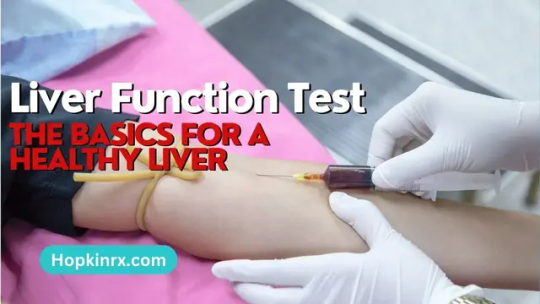
View On WordPress
#ALP Test#ALT Test#AST Test#Bilirubin Levels#Hepatic Function Test#LFT#Liver Blood Test#Liver Diseases#Liver Dysfunction#Liver Enzymes#Liver Function Analysis#Liver Function Assessment#Liver Function Diagnosis#Liver Function Evaluation#Liver Function Monitoring#Liver Function Screening#Liver Function Test#Liver Function Test Cost#Liver Function Test Interpretation#Liver Function Test Procedure#Liver Health#Liver Health Check#Liver Health Checkup#Liver Panel#Liver Test Results
0 notes
Text
If it had not come from a government report I would have had difficulty believing this horrifying case history.
Aaron Kheriaty, MD
Nov 01, 2024
According to a recent report (see page 13) from the Chief Coroner’s office of Ontario, a patient with mental health conditions, including severe depression and PTSD, and a covid vaccine injury was euthanized in Canada, instead of receiving treatment for his physical and mental disorders. This case report shows how the Canadian healthcare system abandoned a suicidal patient in need of real medical and psychiatric care (in Canada, euthanasia is euphemistically termed Medical Assistance in Dying [MAiD]):
Mr. A was a male in his late 40s who experienced suffering and functional decline following three vaccinations for SARS-Cov-2. He received multiple expert consultations, with extensive clinical testing completed without determinate diagnostic results. Amongst his multiple specialists, no unifying diagnosis was confirmed. He had a significant mental health history, including depression and trauma experiences. While navigating his physical symptoms, Mr. A was admitted to hospital with intrusive thoughts of dying. Psychiatrists presented concerns of an adjustment disorder, depression with possible psychotic symptoms, and illness anxiety/somatic symptom disorder. During a second occurrence of suicidal ideation, Mr. A was involuntarily hospitalized. During this hospitalization, post-traumatic stress disorder was thought to be significantly contributing to his symptoms. He received inpatient psychiatric treatment and care through a specialist team. He was also diagnosed with cluster B and C personality traits. The MAiD assessors opined that the most reasonable diagnosis for Mr. A’s clinical presentation (severe functional decline) was a post-vaccine syndrome, in keeping with chronic fatigue syndrome, also known as myalgic encephalomyelitis. No pathological findings were found at the time of post-mortem examination. The cause of death following post-mortem examination was provided as post COVID-19 vaccination.
This case report was brought to my attention by my colleague Alexander Raikin at the Ethics and Public Policy Center, who is carefully documenting the concerning developments of the euthanasia regime in Canada. As he explains, “In just six years, the number of deaths from euthanasia or MAiD increased thirteenfold, from 1,018 deaths in 2016 to over 13,200 deaths in 2022. More Canadians die by euthanasia than from liver disease, Alzheimer’s, diabetes, or pneumonia. In fact, MAiD is now effectively tied as the fifth leading cause of death in the country.” Nearly one in twenty deaths in Canada is now by Euthanasia. If you are interested in more on this topic I recommend this recent interview and this article by Raikin (or this longer report for those who want a deeper dive).
13 notes
·
View notes